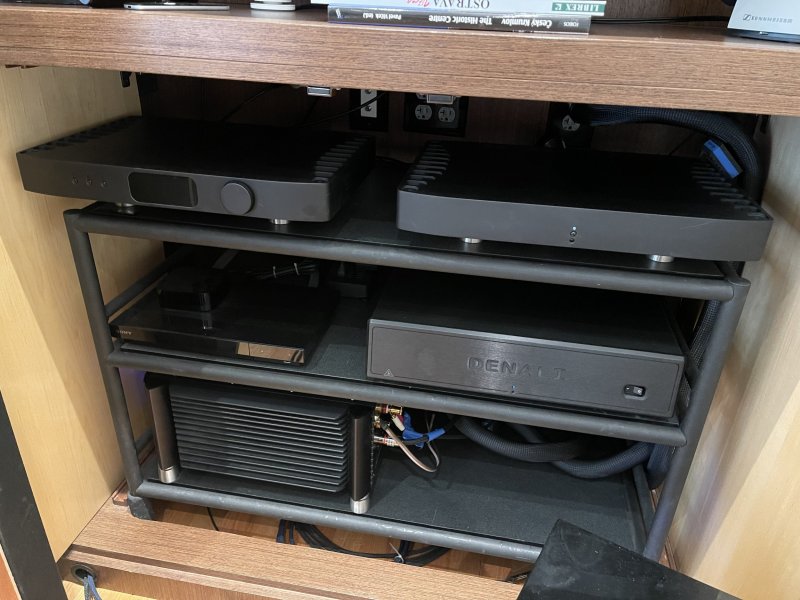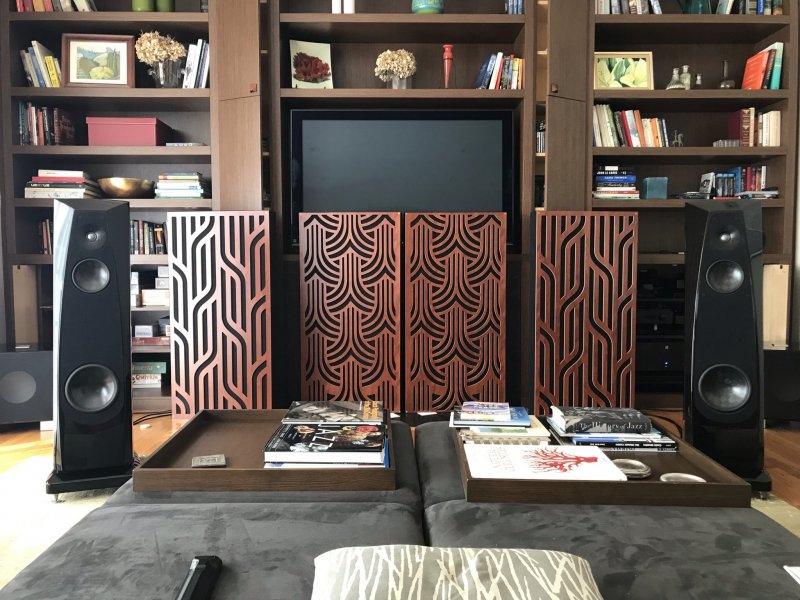

After return to some post-pandemic normalcy, recently I listened again to the system of WBF member Vlad (VLS). While with some reservations I had liked the system on previous occasions, now a year later I listened to some of the best sound I had ever heard from a system. This is a remarkable transformation, and it is the more remarkable since the system does not feature the most expensive components, at least by today's high end standards. In particular, the Rockport Atria II is the entry level speaker from the company.
Here is a list of Vlad’s gear, provided by him:
• MSB Premier + Powerbase + Femto 93 clock + Renderer
• SoTM ISO-CAT6 Ethernet filter just before the renderer
• Running Roon on an iMac, connected to the DAC via wired Ethernet and a basic TP-LINK 1Gb switch. Roon connects to Qobuz, Tidal, and ripped CDs and high-rez files on the iMac.
• Amp: Simaudio Moon 860A v1
• Interconnects: Shunyata Alpha
• Speaker cables: Shunyata Cobra
• Speakers: Rockport Atria II, two REL S/3 SHO subs connected to the amp speaker terminals
• Power: dedicated 10AWG AC line; Denali v2 + Shunyata Sigma XC v2 PC (input) + 2 Shunyata Sigma NR v2 PCs (output)
The tremendous progress in sound that the system has made last year seems to be due mainly to three factors:
1) using the MSB DAC direct output, via internal volume control, into the power amp, instead of using an external preamp
2) a complete upgrade of the Shunyata power conditioning system, with exchange of the Denali v1 for a Denali v2, and upgrade of the power cords (see above)
3) putting the speakers on spikes rather than on flat footers
I was struck by the tremendous dynamics, which were new. The sound was incredibly vivid and, in a good way, incisive, just as I personally like it. There was also a great, to my ears very natural tone. Personally, I would have liked a bit less speaker toe-in, which would have provided slightly less emphasis on upper midrange/lower treble, but this is a matter of taste I would say. Interestingly, even with this slight emphasis on high frequencies, the system never sounded bright, thin or aggressive. Cymbals had solid meat on their bones. Despite the energy in the higher frequencies, there was mostly great body in the sound, for example on orchestral low brass or on drums.
Undeniable was the stunning clarity and transparency of tone and of musical lines, which made following and being caught up in the music very easy. There was also an extraordinary level of resolution of timbral micro-detail, among the best that I have heard. For example, on solo cello (Bach cello suites, Starker, digital recording from the 90s when the cellist was in his seventies) the cello sound had an incredible definition and detail throughout the entire range, including the low register (which albeit did not quite have the body that can be obtained from this recording, but still was very good in that respect).
A good part of what made the tone so convincing to me was the incredible richness and shadings of color, with an illumination of tone from within. This richness and diversity of color, rarely heard from a hifi system, very much reminded me of live music.
Even though Vlad exclusively sources music from streaming, there was never a hint of the synthetic, plasticky quality that I often associate with less than the best computer audio. It all sounded very much artifact-free and natural.
There might have been a slight etching of sound in some instances, but I assume this would go away or be very much reduced with a bit less speaker toe-in and concomitant less emphasis on higher frequencies. Yet in most instances there was sublime flow of the music, which made the presentation very life-like.
Rhythm & timing was outstanding, greatly contributing to the involvement in the music. I am very sensitive to this issue, and rhythm & timing is one of the strong suits of my system, which I use as a reference in this area. The jazz rock of Trio of Doom had just the same explosive, tight and propulsive rhythm as on my system; here Vlad’s system has also made tremendous progress, as it was less than convincing on this material before, with some sluggishness. This also showed the tremendous quality of the MSB DAC, next to dynamics and of course tone, as well as resolution of timbral micro-detail. So far I had not been quite convinced, but now it was obvious that the DAC is outstanding in every way. The perceived lack of any digital artifact from streamed music shows the superiority of MSB’s streaming solution with internal renderer, inside the DAC box, which apparently circumvents the need for an expensive external server. If I were to implement streaming in my system (no intention at this point), I would primarily explore the MSB DAC with its in-box streaming renderer.
The jazz rock of Trio of Doom also revealed the great reduction of a weakness of the system that had bothered me before. There had been a hollow, smeared coloration on some drum sounds, apparently related to a narrow frequency band. It was for me the typical sound of a less than optimally rigid box speaker, a reminder why I usually do not like box floor standers unless they are of exceptional quality. Yet putting the Rockport speakers on spikes very much reduced the problem, up to a point where it really comes down to nitpicking when trying to find a fault. Drums sounded solid and very weighty. Mid-bass energy was just excellent. In general the sound was now remarkably box-free.
The sound was always effortless. There was a generous big-sized quality of sound that had not been there before, when the presentation was smaller – also in soundstage -- and less filled with energy.
Overall the system was incredibly engaging, and the presentation let you concentrate on the music rather just than the sound. Also in this of course most important sense, it was among the best systems I have heard so far.
I would also say that it was the best Rockport sound that I have ever heard, by a rather wide margin. Yes, the Rockport Lyra at Goodwin’s did some spectacular things, like just a huge soundstage on orchestral music and (from digital source, dCS Vivaldi four-box player) the most natural rendition and best resolution of the sound of a large orchestral violin section that I have ever heard, but there were problems and it was not all around satisfying like this sound is to me. On two other occasions, with Rockport Cygnus, I have heard just a boring sound, and an Altair demo was very unsatisfying as well. Clearly, nothing beats a thoroughly optimized sound as it can almost only be achieved in a home setting.
There was only one downside of the sound in Vlad’s system that was also a reduction in quality from what he had before, which is some a loss of spatial information. The presentation was rather one-dimensional in depth; the same components in the previous configuration had allowed for much greater spatial depth. If this is due to the direct coupling of the MSB DAC to the power amp, or the new Shunyata power components, or both, is not clear at this point. On the other hand, the rendition of hall ambience, while lacking in some instances, was sublime in others, for example on Haydn piano sonatas played by John McCabe (Decca).
In that context I have to add a caveat as well: the great incisiveness and energy of the music, as well as the extraordinary resolution of detail, certainly was intrinsic to the system’s capabilities, but in part it was also enhanced by the always upfront presentation, including of otherwise background layers.
Yet this is nitpicking on an otherwise magnificent system sound. Vlad also informed me that now he has version 2 of the Simaudio amp on audition, which significantly improves the sound further…

